
Mohave or Mojave are a Native American people indigenous to the Colorado River in the Mojave Desert. The Fort Mojave Indian Reservation includes territory within the borders of California, Arizona, and Nevada. The Colorado River Indian Reservation includes parts of California and Arizona and is shared by members of the Chemehuevi, Hopi, and Navajo peoples.

The American Indian Wars, also known as the American Frontier Wars, and the Indian Wars, were initially fought by European governments and also by the colonists in North America, and later by the United States government and American settlers, against various American Indian tribes. These conflicts occurred in the United States from the time of the earliest colonial settlements in the 17th century until the end of the 19th century. The various wars resulted from a wide variety of factors, the most common being the desire of settlers and governments for Indian tribes' lands. The European powers and their colonies also enlisted allied Indian tribes to help them conduct warfare against each other's colonial settlements. After the American Revolution, many conflicts were local to specific states or regions and frequently involved disputes over land use; some entailed cycles of violent reprisal.

The Modoc War, or the Modoc Campaign, was an armed conflict between the Native American Modoc people and the United States Army in northeastern California and southeastern Oregon from 1872 to 1873. Eadweard Muybridge photographed the early part of the US Army's campaign.

The Modoc are an Indigenous American people who historically lived in the area which is now northeastern California and central Southern Oregon. Currently, they include two federally recognized tribes, the Klamath Tribes in Oregon and the Modoc Tribe of Oklahoma, now known as the Modoc Nation.
The Battle of Lost River in November 1872 was the first battle in the Modoc War in the northwestern United States. The skirmish, which was fought near the Lost River along the California–Oregon border, was the result of an attempt by the U.S. 1st Cavalry Regiment of the United States Army to force a band of the Modoc tribe to relocate back to the Klamath Reservation, which they had left in objection of its conditions.
The Snake War (1864–1868) was an irregular war fought by the United States of America against the "Snake Indians," the settlers' term for Northern Paiute, Bannock and Western Shoshone bands who lived along the Snake River. Fighting took place in the states of Oregon, Nevada, and California, and in Idaho Territory. Total casualties from both sides of the conflict numbered 1,762 dead, wounded, or captured.
The Shastan peoples are a group of linguistically related Indigenous peoples from the Klamath Mountains. They traditionally inhabited portions of several regional waterways including the Klamath, Salmon, Sacramento and McCloud rivers. Shastan lands presently form portions of the Siskiyou, Klamath and Jackson counties. Scholars have generally divided the Shastan peoples into four languages, although arguments in favor of more or less existing have been made. Speakers of Shasta proper-Kahosadi, Konomihu, Okwanuchu, and Tlohomtah’hello "New River" Shasta resided in settlements typically near a water source. Their villages often had only either one or two families. Larger villages had more families and additional buildings utilised by the community.
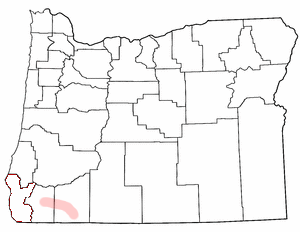
The Rogue River Wars were an armed conflict in 1855–1856 between the U.S. Army, local militias and volunteers, and the Native American tribes commonly grouped under the designation of Rogue River Indians, in the Rogue River Valley area of what today is southern Oregon. The conflict designation usually includes only the hostilities that took place during 1855–1856, but there had been numerous previous skirmishes, as early as the 1830s, between European American settlers and the Native Americans, over territory and resources.

The Round Valley Indian Reservation is a federally recognized Indian reservation lying primarily in northern Mendocino County, California, United States. A small part of it extends northward into southern Trinity County. The total land area, including off-reservation trust land, is 93.939 km2. More than two-thirds of this area is off-reservation trust land, including about 405 acres (1.64 km2) in the community of Covelo. The total resident population as of the 2000 census was 300 persons, of whom 99 lived in Covelo.
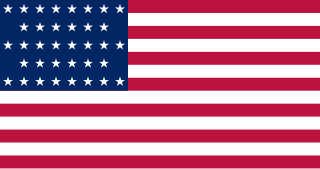
The First Regiment Oregon volunteer Cavalry was a volunteer regiment in United States service Union army that was formed in response to the American Civil War. With men recruited in Oregon and some recruited in surrounding states, the regiment primarily served to protect the state of Oregon and surrounding territories during the American Civil War.
The Pitt River Expedition is a series of expeditions in the U.S. state of California in the 1850s. The expeditions are named for the Pit River, one of many tributaries of the Sacramento River, and the Pitt River Indians. The expeditions were part of the larger American Indian Wars and took place during the California Gold Rush.
Klamath and Salmon River War, or Klamath War, or Red Cap War, or Klamath River Massacres, was an American Indian War which occurred in Klamath County California from January to March 1855. The war began from incidents between local settlers and local Indians and a rumor of an Indian uprising against the miners along the Klamath River by the Yurok and Karok Native American tribes. Local miners wanted the Indians armed with guns and ammunition disarmed, anyone trading them to the Indians whipped and expelled from the County and any Indian found with firearms after that time was to be killed. Some of the Indians, mainly a group called the "Red Caps", refused to disarm, and hostilities began between them and the miners. Troops from the California State Militia and U. S. Army eventually stepped in.The conflict resulted in killings on both sides.

1st Battalion California Volunteer Mountaineers was an infantry battalion in the Union Army during the American Civil War. It spent its entire term of service in the western United States, attached to the Department of the Pacific. It was organized from men from the counties of Humboldt, Mendocino, Trinity, Klamath, Siskiyou, and Del Norte, and other parts of California, between May 30, 1863, and March 16, 1864, for special service in the redwood forests and mountains that was being fought over in the Bald Hills War in Humboldt County within the Humboldt Military District. The Battalion mustered out June 14, 1865.

The Yuma War was the name given to a series of United States military operations conducted in southern California and what is today southwestern Arizona from 1850 to 1853. The Quechan were the primary opponent of the United States Army, though engagements were fought between the Americans and other native groups in the region.

Bald Hills War (1858–1864) was a war fought by the forces of the California Militia, California Volunteers and soldiers of the U.S. Army against the Chilula, Lassik, Hupa, Mattole, Nongatl, Sinkyone, Tsnungwe, Wailaki, Whilkut and Wiyot Native American peoples.
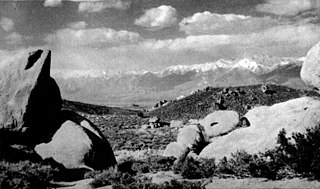
The Owens Valley War was fought between 1862 and 1863 by the United States Army and American settlers against the Mono people and their Shoshone and Kawaiisu allies in the Owens Valley of California and the southwestern Nevada border region. The removal of a large number of the Owens River indigenous Californians to Fort Tejon in 1863 was considered the end of the war. Minor hostilities continued intermittently until 1867.
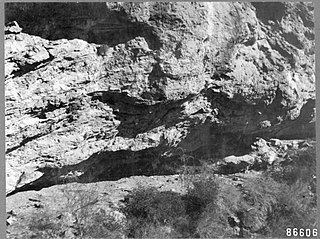
The Yavapai Wars, or the Tonto Wars, were a series of armed conflicts between the Yavapai and Tonto tribes against the United States in the Arizona Territory. The period began no later than 1861, with the arrival of American settlers on Yavapai and Tonto land. At the time, the Yavapai were considered a band of the Western Apache people due to their close relationship with tribes such as the Tonto and Pinal. The war culminated with the Yavapai's removal from the Camp Verde Reservation to San Carlos on February 27, 1875, an event now known as Exodus Day.

Charles Stewart Drew, also known as C.S. Drew, was a representative in the legislature of the Oregon Territory of the United States and quartermaster general of the territorial militia in the 1850s. During the American Civil War, he was a Union Army officer, serving in the 1st Oregon Cavalry regiment. He eventually reached the rank of lieutenant colonel. In 1864, he led an Army reconnaissance party into southeastern Oregon. The expedition, known as the Owyhee Reconnaissance, traveled through uncharted country from Fort Klamath to Fort Boise and back. Drew was the author of two historically important military reports; one documented Indian attacks on American settlers in the Oregon Territory and the other was his report of the Owyhee Reconnaissance.
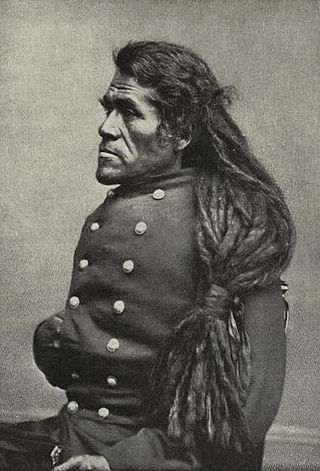
Irataba was a leader of the Mohave Nation, known as a mediator between the Mohave and the United States. He was born near the Colorado River in present-day Arizona. Irataba was a renowned orator and one of the first Mohave to speak English, a skill he used to develop relations with the United States.

The California genocide was a series of systematized killings of thousands of Indigenous peoples of California by United States government agents and private citizens in the 19th century. It began following the American Conquest of California from Mexico, and the influx of settlers due to the California Gold Rush, which accelerated the decline of the Indigenous population of California. Between 1846 and 1873, it is estimated that non-Natives killed between 9,492 and 16,094 California Natives. Hundreds to thousands were additionally starved or worked to death. Acts of enslavement, kidnapping, rape, child separation and forced displacement were widespread. These acts were encouraged, tolerated, and carried out by state authorities and militias.














